Alpha Centauri B may have "superhabitable" worlds
By David Szondy
January 27, 2014
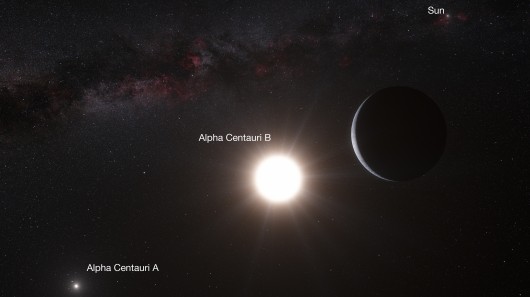
The Alpha Centauri system and hypothetical planet (Image: European Southern Observatory)
Since Earth is the only known inhabited planet and we happen to live here, it’s only natural to regard it as the ideal place for life to exist, and to assume that another life-bearing planet would be fairly similar. However, that is not the opinion of scientists René Heller and John Armstrong who contend that there might be a planet even more suitable for life than Earth 4.3 light years away orbiting the star Alpha Centauri B.
The nice thing about having a hypothetical “superhabitable” planet revolving around Alpha Centauri B, which is part of a triple star system, is that it makes it a lot easier to indulge in a bit of a thought experiment based on the arguments put forward by Heller, of the Department of Physics and Astronomy, McMaster University, Hamilton in Ontario, Canada, and Armstrong, of the Department of Physics, Weber State University in Ogden, Utah.
Imagine we’re in a spaceship approaching the planet in question. The first thing we’d notice is that its sun isn't a familiar yellow. Instead, it’s orange. That’s because where our Sun is a yellow G2 star, Alpha Centauri B is a K-type dwarf star, hence the orange tinge.
If you want a habitable planet, you need the right sun. The longer a sun lives and remains stable, the longer life has to emerge and evolve. If the sun in question is too large, then it will have a very short life. If it’s too small, it might last a long time, but the planet will have to be very close to stay warm and that can cause all sorts of problems, such as tidally locking the planet, so one side is always in daylight and the other in night, which isn't good. And then there’s the problem of suns that put out too much X-ray or ultraviolet radiation, or lack the elements needed to form planets that can support biochemistry.
Our Sun is a G2-type star. It’s fairly well behaved and has been so for 4.6 billion years. However, K-type dwarfs, which are smaller than the Sun, have lives longer than the age of the Universe. Heller and Armstrong argue that the longer a planet is inhabited, the more habitable it becomes due to a perpetual increase in biodiversity, so an older planet revolving around an older sun will be a better home for life. Alpha Centauri B is specifically a K1V-type star that fits the bill with an estimated age of between 4.85 and 8.9 billion years, and is already known to have an Earth-like planet called, disappointingly, Alpha Centauri B b.
As to the planet we’re looking for, if it exists, it will be located somewhere between 0.5 and 1.4 astronomical units (46 – 130 million mi, 75 – 209 million km) from Alpha Centauri B. Actually, we can be even more precise than that. All things being equal, it will be in a circular orbit 1. 85 AU (172 million mi, 276 million km) away. This would place it in the middle of the "stellar habitable zone," also known as the "Goldilocks zone" or the "Temperate Zone." This is the area surrounding Alpha Centauri B where it’s neither too hot for liquid water to exist, nor too cold for the planet to be anything but a giant snowball.
Not surprisingly, the Earth sits in the Sun’s habitable zone, though Heller and Armstrong point out that it only just does, which means that our planet isn't exactly ideal because it could one day end up like Venus if things go pear shaped. Indeed, the researchers go so far as to say that Earth may not even be a typical inhabited planet.
Our superhabitable planet might not even be in the habitable zone. It could be a moon of some giant planet further away. Jupiter’s moon Io is a volcanic hellhole due to tidal heating. A larger moon that Heller and Armstrong call a "Super Europa" in the right orbit around a gas giant could heat enough to support life even if it’s technically outside the star’s habitable zone.
According to Heller and Armstrong, as we orbited above the planet, it would look very different from our own. It would be an older world, larger and more rugged, which would provide more places for life to exist. It would also be slightly more massive, which means more gravity.
That’s because for a planet to sustain life, it has to be geologically active. It has to have a rotating molten core to generate a magnetic field to ward off cosmic radiation and protect the atmosphere from being stripped away by solar winds. In addition, on Earth carbon dioxide is absorbed into silicates because of all the water present. Plate tectonics constantly draw these silicates into the molten interior, where they’re melted and the carbon dioxide returned to the atmosphere, which helps prevent the planet from overcooling and freezing. A slightly more massive planet with more gravity means more tectonic activity, so a better magnetic field and a more stable climate.
However, the most striking difference between the superhabitable world and Earth would be that the former would lack our continents and deep oceans. However much they may add to the aesthetic value of a planet and give it a nice baroque feel, large continents tend to have large deserts in their interiors and deep oceans are relatively lacking in life. Instead, Heller and Armstrong see a world with less water than ours, which would help to avoid both a runaway greenhouse effect and a snowball planet that an overabundance of water can trigger by either trapping heat or reflecting it away, depending on conditions.
What water there is on our hypothetical planet would be evenly scattered across the surface in the form of lakes and small, shallow seas. This way, the shallow waters would hold much larger populations of more diverse life than is found on Earth, while the temperatures would be moderated. However, it would be a warmer world than Earth, which also makes for more diversity and potentially more oxygen, thanks to the higher gravity which helps retain any atmosphere.
One point that Heller and Armstrong make is that there may be more than one habitable planet in the Alpha Centauri B system. Cosmic bombardments early in the history of the Solar System is how the Earth got its water and minerals in the crust. If life had already emerged on one planet of Alpha Centauri B during its own early history, then the bombardment might have spread it to other worlds and back again as a sort of cross pollination, which would also make these worlds superhabitable.
Heller and Armstrong's paper is published in the January 16 issue of Astrobiology.
Source: Planetary Habitability Laboratory
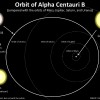
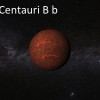
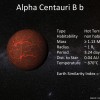
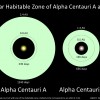
 David Szondy
is a freelance writer based in Monroe, Washington. An award-winning
playwright, he has contributed to Charged and iQ magazine and is the
author of the website Tales of Future Past.
David Szondy
is a freelance writer based in Monroe, Washington. An award-winning
playwright, he has contributed to Charged and iQ magazine and is the
author of the website Tales of Future Past.